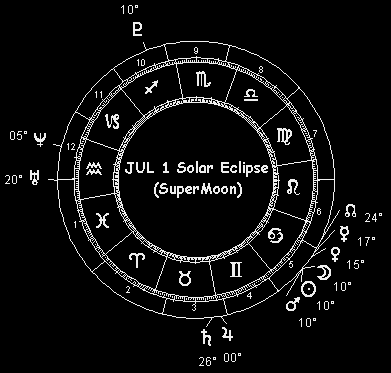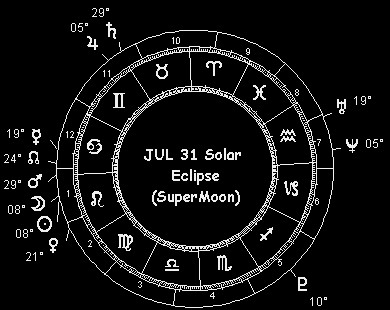If you were expecting some kind of sun sign nonsense, forget it. This is real astrology. See the section above. Please note: this forecast is expressed in terms of Universal Time (UT). Current UT date and time appear at the top of this page. (To update display, use your browser's reload/refresh button.)
 July features a fairly rare trio of eclipses (including the last New Blue Moon and the last pair of SuperMoons in the 20th Century), plus some continuing major planet themes from earlier months. Economic issues - from big financial powerhouses like governments, banks and the markets down to the microeconomic cogs like the family farm - will be a major focus all month long, under the aegis of those continuing major planet themes. Fires, drought and destructive storms - sometimes too much of a good thing is as damaging as too little - are bound to make headlines just about throughout July.
July features a fairly rare trio of eclipses (including the last New Blue Moon and the last pair of SuperMoons in the 20th Century), plus some continuing major planet themes from earlier months. Economic issues - from big financial powerhouses like governments, banks and the markets down to the microeconomic cogs like the family farm - will be a major focus all month long, under the aegis of those continuing major planet themes. Fires, drought and destructive storms - sometimes too much of a good thing is as damaging as too little - are bound to make headlines just about throughout July.
A generally positive atmosphere marks major equity markets starting around mid-month, building toward a September peak that signals a short-term correction. With Mercury's retrograde continuing until the 17th, labor concerns (including shortages as well as strikes and other union actions) tend to generate uncertainties in the markets until then - not to mention service disruptions that inconvenience the public at large. Speaking of disruptions, utility outages, transportation system tie-ups and communication breakdowns are par for the course during this period. They'll ease after the 17th, and normal bandwidth will be fully restored by month's end - except for the weather-related snags, which will be unavoidable as July turns into August.
Closer to home, you'd do well to double-check everything while Mercury is retrograde, just to be on the safe side. Plans have a way of going awry, mistakes happen more often, errors in communication are par for the course. In short, it's a time when the course of wisdom is to expect that very little comes off right without a lot of extra care and attention. Assume nothing! And figure that some of the mistakes made since Mercury's retrograde began back on June 23 won't be discovered until sometime around the 17th of this month - unless you make the extra effort and do the follow-ups before then.
July is chock-full of risk windows for severe storms, flooding and moderate to severe seismic action (Richter 5 or greater quakes as well as volcanic eruptions), so you can figure that Mother Nature is bound to be on some kind of rampage off and on throughout the month. The July 1 SuperMoon solar eclipse (also the last New AnteBlue Moon of the 20th century) at 10 Cancer probably starts it all off with a bang - all the more so because the eclipse occurs within just a couple hours of Luna's closest approach to Earth. In effect June 24 to July 8 - from the Moon's northward to its southward equatorial crossing - but strongest within plus or minus 3 days of the eclipse, this alignment looks especially noteworthy in terms of damaging storms producing heavy rains and the resultant flooding. No doubt, these deluges will be welcome in parched regions suffering from chronic drought. However sometimes too much of a good thing too fast can be a disaster, and this looks like a case in point.
Anytime you're dealing with Sun-Moon-Earth alignments like this, the scale is truly planetary and therefore the seismic and meteorological potential can manifest practically anywhere in the world during the indicated risk period. That said, a look at the astro-locality map of the July 1 SuperMoon eclipse may offer some hints about specific target areas. For example, the India-Pakistan border lies along a north-south risk zone during this period - a zone mirrored half a world away along the Pacific coast of Mexico and northward into the western US and Canada. Also in the bulls eye this time around is a sweeping arc that runs across northwestern Africa into Europe, sweeping from there across northern Russia and then out through the Korean Peninsula and Japan down to New Zealand. Southern Argentina and Chile, where the eclipse is visible, may also be at risk of seismic and meteorological events during the June 24 - July 8 period.
Mars is central to this eclipse: aggression abounds. In other words, Mother Nature is not the only threat at times like this: man's inhumanity to man tends to get a bit out of hand as well. Heaven knows there's plenty of this every day of the year - but there's bound to be more than usual during this SuperMoon phase. If you see an unusual spate of headlines detailing crimes of violence and military or paramilitary conflict . . . well, that's par for the course.
 One new seismic and meteorological risk window after another dominates almost the entire second half of July, starting with the lunar eclipse that forms on the 16th at 24 Capricorn (just a day before the Mercury station at 10 Cancer, the degree of the July 1 solar eclipse). In effect July 13-19, and probably strongest on the 15th (when the Moon reaches maximum southern declination) and 16th, this is another sign of storms and seismic upheaval. This one will likely play special havoc with transportation and communications infrastructure - and equity markets, come to think of it. Fortunately, as fierce as it may be this is a short cycle. In a few days, things are nearly if not entirely back on track - at least for a while. Mars still being quite strong at the time of this eclipse, deaths and injuries due to human error or intent are likely to surge into headline prominence again during this period: a great need of peacemakers, a good time to avoid the kind of places where trouble is likely to strike.
One new seismic and meteorological risk window after another dominates almost the entire second half of July, starting with the lunar eclipse that forms on the 16th at 24 Capricorn (just a day before the Mercury station at 10 Cancer, the degree of the July 1 solar eclipse). In effect July 13-19, and probably strongest on the 15th (when the Moon reaches maximum southern declination) and 16th, this is another sign of storms and seismic upheaval. This one will likely play special havoc with transportation and communications infrastructure - and equity markets, come to think of it. Fortunately, as fierce as it may be this is a short cycle. In a few days, things are nearly if not entirely back on track - at least for a while. Mars still being quite strong at the time of this eclipse, deaths and injuries due to human error or intent are likely to surge into headline prominence again during this period: a great need of peacemakers, a good time to avoid the kind of places where trouble is likely to strike.
Speaking of places where trouble is likely to strike, being a lunar eclipse this alignment is of course planetary in scale. So no place on Earth is beyond its reach, and discretion is the better part of valor regardless of where you plan to be when the Moon plays tag with Earth's shadow. Still, all else being equal, I'd say the risk window in this case is especially strong along a north-south line from the east coast of Brazil through eastern Greenland. This zone is mirrored by another north-south swath from eastern Australia through Papua New Guinea, northward from there through the Sea of Okhotsk between Japan and Kamchatka: these are the regions where the entire eclipse will be visible. Alaska, India, eastern China, Mongolia and the far eastern stretches of Russia round out the risk sectors during this lunar eclipse.
 There's only a brief lull in the seismic and meteorological storm surge after the eclipse window dies down on the 19th. Things get stirred up again within plus or minus 30 hours of the Moon's northward crossing of the celestial equator on the 22nd, and stay that way right into August under the aegis of the SuperMoon solar eclipse that closes out the month on the 31st at 8 Leo - the last New Blue Moon of the 20th Century, in effect July 24-August 7. Strong storms, resorts and cruise ships make for an unlucky combination at times like this, that's for sure. At least Mars isn't so strongly placed this time around. I take this as a sign that Mother Nature's wrath rather than man's inhumanity to man will be the major focus during this period. Especially if you live in a coastal area, stay alert for this one - and especially between July 28 (as the Moon nears maximum northern declination) and August 5 (the day after the Moon crosses the celestial equator headed southward).
There's only a brief lull in the seismic and meteorological storm surge after the eclipse window dies down on the 19th. Things get stirred up again within plus or minus 30 hours of the Moon's northward crossing of the celestial equator on the 22nd, and stay that way right into August under the aegis of the SuperMoon solar eclipse that closes out the month on the 31st at 8 Leo - the last New Blue Moon of the 20th Century, in effect July 24-August 7. Strong storms, resorts and cruise ships make for an unlucky combination at times like this, that's for sure. At least Mars isn't so strongly placed this time around. I take this as a sign that Mother Nature's wrath rather than man's inhumanity to man will be the major focus during this period. Especially if you live in a coastal area, stay alert for this one - and especially between July 28 (as the Moon nears maximum northern declination) and August 5 (the day after the Moon crosses the celestial equator headed southward).
Being planetary in scale, a SuperMoon is global in reach: the storm and seismic potential it signifies can manifest far and wide 'round Planet Earth. Still, glancing at an astro-locality map might suggest areas which could be target zones this time around. As noted in my Year 2000 Forecast Highlights, the western US lies in the target zone for this one, as well as most of Europe, East Africa and the Middle East. (The eclipse will be visible from northern Scandinavia, eastern Russia, Alaska, western Canada and the northwestern US.) A pair of north-south swatches round out the risk sectors during this SuperMoon eclipse: one runs from Greenland down through eastern South America, and the other from Japan down through eastern Australia.
 SPECIAL FEATURE: This month's birthdays of the famous and infamous (with astrological birth charts)
SPECIAL FEATURE: This month's birthdays of the famous and infamous (with astrological birth charts)
